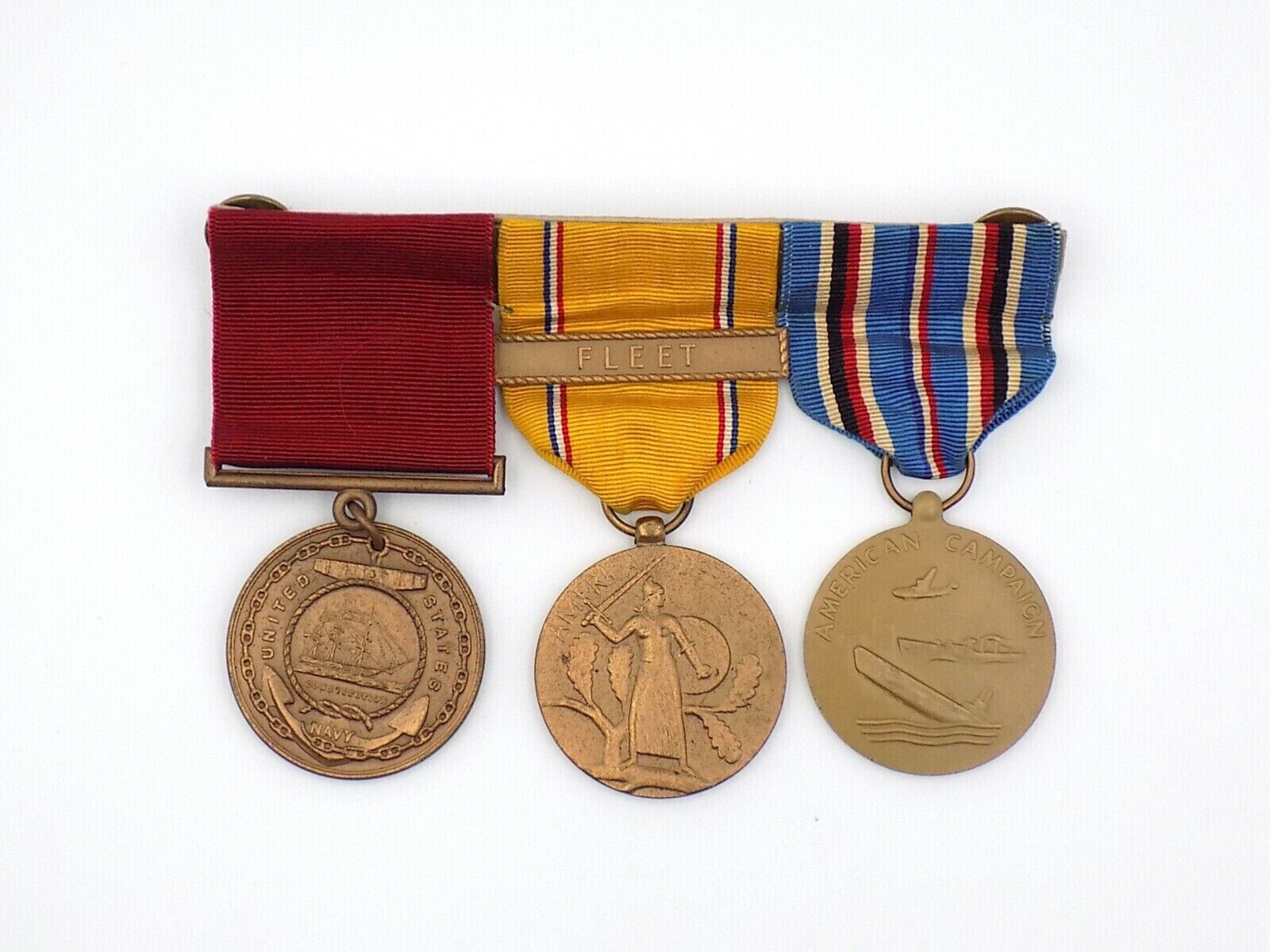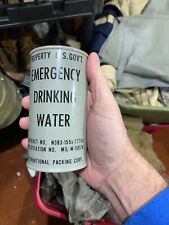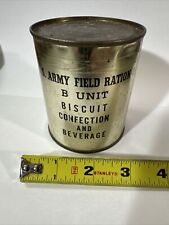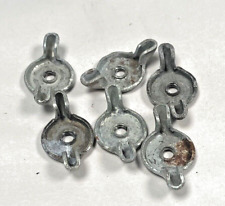Original WWII US Navy Good Conduct 1941 Medal Bar Named--WW2 RARE -SEE STORE WW2 For Sale

When you click on links to various merchants on this site and make a purchase, this can result in this site earning a commission. Affiliate programs and affiliations include, but are not limited to, the eBay Partner Network.
Original WWII US Navy Good Conduct 1941 Medal Bar Named--WW2 RARE -SEE STORE WW2:
$139.99
PLEASE FOLLOW OUR E BAY STORESEE ALL PICSSALE SEE OUR STOREPLEASE READ WHOLE ADDOriginal WWII US Navy Good Conduct 1941 Medal Bar
Nice vintage medal bar. Nice grouping of full size medals including:
- US Navy Good Conduct Medal Named and Dated
- American Defense Medal with Fleet Bar
- American Campaign Medal
United States Navy in World War IIMain articles:Naval history of World War II,Military history of the United States during World War II,History of United States Naval Operations in World War II (series), andPacific WarThesurrender of Japanto Allied forces on theUSSMissourion September 2, 1945
TheUnited States Navygrew rapidly during its involvement inWorld War IIfrom 1941–45, and played a central role in thePacific WaragainstImperial Japan. It also assisted the BritishRoyal Navyin the naval war againstNazi GermanyandFascist Italy. The U.S. Navy grew slowly in the years prior toWorld War II, due in part to internationallimitations on naval constructionin the 1920s. Battleship production restarted in 1937, commencing with theUSSNorth Carolina. The US Navy was able to add to its fleets during the early years of the war while the US was still neutral, increasing production of vessels both large and small, deploying a navy of nearly 350 major combatant ships by December 1941 and having an equal number under construction.[1]
TheImperial Japanese Navy(IJN) sought naval superiority in the Pacific by sinking the main American battle fleet at Pearl Harbor, which was tactically centered around its battleships. The December 1941 surpriseattack on Pearl Harbordid knock out the battle fleet, but it did not affect the three U.S.aircraft carriers, which were at sea at the time of the attack. These became the mainstay of the rebuilt fleet. Naval doctrine had to be changed quickly. The United States Navy (like the IJN) had followedAlfred Thayer Mahan\'s emphasis on concentrated groups of battleships as the main offensive naval weapons.[2]The loss of the battleships at Pearl Harbor forced AdmiralErnest J. King, the head of the Navy, to place a primary emphasis on the small number of aircraft carriers.[3]
The U.S. Navy grew tremendously as the United States was faced with a two-front war on the seas. It achieved notable acclaim in thePacific Theater, where it was instrumental to the Americans\' successful \"island hopping\" campaign.[4]The U.S. Navy fought six great battles with the Imperial Japanese Navy (IJN): theAttack on Pearl Harbor,Battle of the Coral Sea, theBattle of Midway, theBattle of the Philippine Sea, theBattle of Leyte Gulf, and theBattle of Okinawa.[5]By war\'s end in 1945, the United States Navy had added nearly 1,200 major combatant ships, including ninety-nine aircraft carriers, eight \"fast\" battleships, and ten prewar \"old\" battleships[6]totaling over 70% of the world\'s total numbers and total tonnage of naval vessels of 1,000 tons or style=\"margin: 0.5em 0px 0px; padding-bottom: 0.5em;\">On 16 June 1941, after negotiation withChurchill, Roosevelt ordered the United States occupation ofIceland, to replace theBritish occupation forcein theAllied occupationof the island. On 22 June 1941, theU.S. Navysent Task Force 19 (TF 19) fromCharleston, South Carolina, to assemble atArgentia, Newfoundland. TF 19 included 25 warships and the1st Provisional Marine Brigadeof 194 officers and 3,714 men fromSan Diego, Californiaunder the command of Brigadier GeneralJohn Marston.[9]Task Force 19 (TF 19) sailed from Argentia on 1 July. On 7 July, Britain persuaded theAlthingto approve an American occupation force under a U.S.–Icelandic defense agreement, and TF 19 anchored offReykjavíkthat evening.U.S. Marinescommenced landing on 8 July, and disembarkation was completed by 12 July. On 6 August, the U.S. Navy established an air base at Reykjavík with the arrival of Patrol Squadron VP-73PBY Catalinasand VP-74PBM Mariners.U.S. Armypersonnel began arriving in Iceland in August, and the Marines were transferred to the Pacific by March 1942.[9]Up to 40,000 U.S. military personnel were stationed on the island, outnumbering adult Icelandic men (at the time, Iceland had a population of about 120,000). The agreement was for the U.S. military to remain until the end of the war, although the U.S. military presence in Icelandremained until 2006.
Pearl Harbor[edit]Main article:Attack on Pearl HarborThe United States Navy\'sPacific Fleetwas caught off guard on the morning of December 7, 1941, when 353Imperial Japanese Navyaircraftheavily bombed Pearl Harborin a surpriseairstrike. At the time of the attack, the United States and Japan were not at war. The first Japanese wave of 183 aircraft arrived at Pearl Harbor at 7:48 am, targeting ships inBattleship Rowin addition to attacking airfields in other places within Honolulu. Most of the damage to the battleships was inflicted in the first 30 minutes of the assault. The battleshipUSSArizonablew up with a tremendous explosion. Riddled with bombs and torpedoes, theUSSWest Virginiasettled on an even keel on the bottom of the harbor. TheUSSOklahomawas hit by four torpedoes and rolled completely over within five minutes, with its bottom and propeller rising above the waters of the harbor. TheUSSCaliforniawas torpedoed and ordered abandoned as it slowly sank in shallow water. The target shipUSSUtahalso was sunk.
At 8:50 am, the second Japanese wave of the attack began with 171 planes. Less successful than the first, it nonetheless inflicted heavy damage. The battleshipUSSNevadahad sustained a torpedo hit during the first wave, but its position at the end of Battleship Row allowed it greater freedom of action than the other moored capital ships. It was attempting to get underway when the second wave hit. It was struck by seven or eight bombs and was grounded at the head of the channel. The battleshipUSSPennsylvaniawas set ablaze by bombs, and the two destroyers moored near it were reduced to wrecks. The destroyerUSSShawwas split in two by a great explosion. Shortly after 9:30 am, the Japanese withdrew back to their carriers.
The damage to Pearl Harbor was great. The USSArizona, USSUtah, and USSOklahomawere completely sunk and were out of service for the remainder of the war. A further 16 ships were sunk or written off as losses during the war. Of the 402 American aircraft in Hawaii, 188 were destroyed and 159 were damaged, 155 of them on the ground. The Navy suffered 2,008 deaths, along with 327 deaths from other U.S. military branches as well as 68 civilians. The Japanese lost 29 planes (nine in the first attack wave, 20 in the second), five midget submarines, and 64 sailors.
In spite of this, the attack failed to damage any American aircraft carriers, which had been providentially absent from the harbor. The Japanese focused on ships and planes yet spared fuel tank farms, naval yard repair facilities, and the submarine base, all of which proved vital for the tactical operations that originated at Pearl Harbor in the ensuing months. American technological skill raised and repaired all but three of the ships sunk or damaged at Pearl Harbor. Most importantly, the shock and anger that Americans felt in the wake of the attack on Pearl Harbor united the nation and was translated into a collective commitment to destroy the Japanese Empire and Nazi Germany.
Aftermath[edit]After Pearl Harbor, the Japanese Navy seemed unstoppable because it outnumbered and outgunned the disorganized Allies—U.S., Britain, Netherlands, Australia, and China. London and Washington both believed in Mahanian doctrine, which stressed the need for a unified fleet. However, in contrast to the cooperation achieved by the armies, the Allied navies failed to combine or even coordinate their activities until mid-1942. Tokyo also believed inMahan, who said command of the seas—achieved by great fleet battles—was the key to sea power. Therefore, the IJN kept its main strike force together underAdmiral Yamamotoand won a series of stunning victories over the Americans and British in the 90 days after Pearl Harbor. Outgunned at sea, the American strategy for victory required a holding action against the IJN until the much greater industrial potential of the U.S. could be mobilized to build a fleet capable of projecting American power to the enemy heartland.
Midway[edit]Main article:Battle of MidwayThe Battle of Midway, together with the Guadalcanal campaign, marked the turning point in thePacific.[10][11][12]Between June 4–7, 1942, theUnited States Navydecisively defeated aJapanese naval forcethat had sought to lure the U.S. carrier fleet into a trap atMidway Atoll. The Japanese fleet lost four aircraft carriers and a heavy cruiser to the U.S. Navy\'sone American carrierand adestroyer. After Midway, and the exhausting attrition of theSolomon Islands campaign, Japan\'s shipbuilding and pilot training programs were unable to keep pace in replacing their losses while the U.S. steadily increased its output in both areas. Military historianJohn Keegancalled the Battle of Midway \"the most stunning and decisive blow in the history of naval warfare.\"[13]
Guadalcanal[edit]Main article:Guadalcanal CampaignGuadalcanal, fought from August 1942 to February 1943, was the first major Allied offensive of the war in the Pacific Theater. This campaign saw American air, naval and ground forces augmented by Australian and New Zealander forces in a six-month campaign slowly overwhelm determined Japanese resistance. Guadalcanal was the key to controlling theSolomon Islands, which both sides saw as strategically essential. Both sides won some battles but both sides were overextended in terms of supply lines.
The rival navies fought seven battles, with the two sides dividing the victories. They were:Battle of Savo Island,Battle of the Eastern Solomons,Battle of Cape Esperance,Battle of the Santa Cruz Islands,Naval Battle of Guadalcanal,Battle of TassafarongaandBattle of Rennell Island. Each of the sides pulled out its aircraft carriers, as they were too vulnerable to land-based aviation.[14]
1943[edit]In preparation of the recapture of the Philippines, the Allies started theGilbert and Marshall Islands campaignto retake those islands from the Japanese in summer 1943. Enormous effort went into recruiting and training sailors and Marines, and building warships, warplanes and support ships in preparation for a thrust across the Pacific, and to support Army operations in the Southwest Pacific, as well as in Europe and North Africa.[15]
1944[edit]The Navy utilized\"island-hopping\"to continue its long movement west across the Pacific, seizing one island base after another. Not every Japanese stronghold had to be captured; some, like the big bases at Truk, Rabaul and Formosa, were neutralized by air attack and then simply isolated and leapfrogged. The ultimate goal was to get close to Japan itself, then launch massive strategic air attacks and finally an invasion. The U.S. Navy did not seek out the Japanese fleet for a decisive battle, asMahaniandoctrine would suggest; the enemy had to attack to stop the inexorable advance.
Normandy: June 1944[edit]Main articles:Invasion of NormandyandNormandy landingsThe invasion of Normandy, France, was the largest and most complex amphibious operation of all time. Casualties were remarkably light, with the Germans having hardly any airpower or seapower to combat it.[16]In the first 30 days, the armada landed 850,000 men, 148,000 vehicles, and 570,000 tons of supplies on the beaches and makeshift ports, for the Germans were holed up in control of all the regular ports.[17]The operation involved 195,000 men from the various navies and merchant marine. The navies used 113,000 British, 53,000 American, and 5,000 men from other allies. In addition there were 25,000 sailors from the Allied merchant navies.[18]Of the combat warships, 17 percent were provided by the United States Navy, and 79 percent by the British or Canadians.[19]Since the preponderance of naval forces were British, the Royal Navy named Vice AdmiralBertram Ramsayas the overall Allied naval commander underEisenhower.[20]
Battle of the Philippine Sea[edit]Main article:Battle of the Philippine SeaThe carrierZuikaku(center) and two destroyers under attack June 20, 1944The climax of the carrier war came at the Battle of the Philippine Sea.[21][22]
Taking control of islands that could support airfields withinB-29range of Tokyo was the objective. 535 ships began landing 128,000 Army soldiers and Marines on June 15, 1944 in theMariana and Palau Islands. The achievement in planning such a complex logistical operation in just ninety days, and staging it 3,500 miles (5,600km) from Pearl Harbor was indicative of American logistic superiority. (The previous week an even bigger landing force hit the beaches of Normandy—by 1944 the Allies had resources to spare.)
The Japanese launched an ill-coordinated attack on the larger American fleet; Japanese planes operated at extreme ranges and could not keep together, allowing them to be easily shot down in what Americans jokingly called the \"Great Marianas Turkey Shoot.\"[23]
Japan had now lost all its offensive capabilities, and the U.S. had control of Guam, Saipan and Tinian islands that provided air bases within range of B-29 bombers targeted at Japan\'s home islands. It was entirely an air battle, in which Americans had all the technological advantages. It was the largest naval battle in history to date, surpassed only by theBattle of Leyte Gulfin October 1944.
Japanese strategy[edit]The American 5th Fleet covering the landing comprised 15 big carriers and 956 planes, plus 28 battleships and cruisers, and 69 destroyers. Tokyo sent Vice AdmiralJisaburo Ozawawith nine-tenths of Japan\'s fighting fleet—it was about half the size of the American force, and included nine carriers with 473 planes, 18 battleships and cruisers, and 28 destroyers. Ozawa\'s pilots boasted of their fiery determination, but they had only a fourth as much training and experience as the Americans. They were outnumbered 2–1 and used inferior equipment. Ozawa had anti-aircraft guns but lackedproximity fuzesand good radar.
Ozawa gambled on surprise, luck and a trick strategy, but his battle plan was so complex and so dependent on good communications that it quickly broke down. His planes carried more gasoline because they were not weighted down with protective armor; they could attack at 300 miles (480km), and could search a radius of 560 miles.[24]The heavier AmericanHellcatscould only attack to 200 miles (320km), and only search to 325. Ozawa\'s plan therefore was to use his advantage in range by positioning his fleet 300 miles (480km) out, forcing the Americans to search over 150,000 square miles (390,000km2) of ocean just to find him. The Japanese ships would stay beyond American range, but their planes would have enough range to strike the American fleet. They would hit the carriers, land at Guam to refuel, then hit the Americans en route back to their carriers. Ozawa counted heavily on the 500 or so ground-based planes that had been flown ahead to Guam and other islands in the area.
1945[edit]Okinawa[edit]Main article:Battle of OkinawaOkinawa was the last great battle of the entire war. The goal was to make the island into a staging area for theinvasion of Japanscheduled for fall 1945. It was just 350 miles (550km) south of the Japanese home islands. Marines and soldiers landed on 1 April 1945, to begin an 82-day campaign which became the largest land-sea-air battle in history and was noted for the ferocity of the fighting and the high civilian casualties with over 150,000 Okinawans losing their lives. Japanesekamikazepilots exacted the largest loss of ships in U.S. naval history with the sinking of 38 and the damaging of another 368. Total U.S. casualties were over 12,500 dead and 38,000 wounded, while the Japanese lost over 110,000 men. The fierce combat and high American losses led the Navy to oppose an invasion of the main islands. The eventualbombings of Hiroshima and Nagasaki, along with theSoviet invasion of Manchukuo, led to theJapanese surrenderin August 1945

Related Items:
ORIGINAL WWII US NAVY & ARMY EMERGENCY DRINKING WATER CAN-SEALED, NOS
$21.59
October 1942 WWII US Army Field Ration C Biscuit Confection Beverage B Unit #2
$250.00
Six (6) Original WWII US Army .50 Cal MG Wood Ammunition Crate Special Wing Nuts
$9.00



